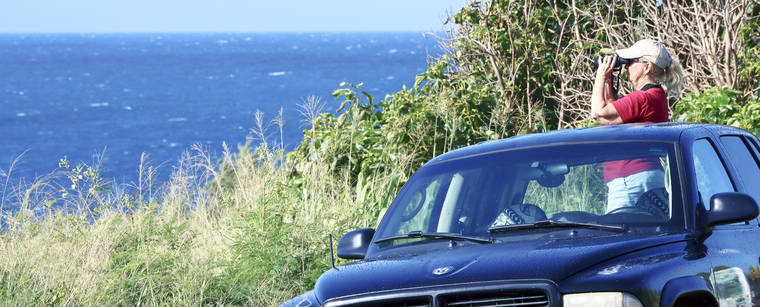PO‘IPU — Most of the whales came early, said Carol Everett, sanctuary site leader at Kaiwa Point Saturday, when the Hawaiian Islands Humpback Whale National Marine Sanctuary and the Pacific Whale Foundation conducted the second of three coordinated whale counts for 2021.
“I didn’t have any sightings for this period,” Everett said. “Earlier, I had up to three sightings. They were all singles, and only blows. The whales must’ve been early.”
Everett was the sole counter at Kaiwa Point because of the modified Sanctuary Ocean Count in response to the ongoing COVID-19 pandemic.
Jean Souza, the HIHWNMS Kaua‘i program specialist, said this year’s count is limited to experienced site leaders only, the leaders being face-masked and physically distanced with no general volunteers and no contact with the public.
“Traditionally, we’d be out on the point,” Everett said. “But look at all the vegetation. I’m in the back of the pickup so I can get some elevation and vantage point over the vegetation.”
Sanctuary spokesperson Cindy Among-Serrao said 72 trained site leaders gathered data from the shores of O‘ahu, Kaua‘i and Hawai‘i Island during the February count that took place Saturday across 42 sites.
“A total of 83 whale sightings were seen during the 9 to 9:15 a.m. time period, the most of any time period throughout the day’s count,” Among-Serrao said of the 30 sites on the three islands.
Kaua‘i’s average sightings over the seven sites utilized amounted to a 1.5 average, with the most sightings reported at Crater Hill in Kilauea, with four sightings, an increase over the three sightings reported in January.
The Kapa‘a Lookout, with its site leaders located far out on the point to avoid contact with public, and Ninini Point, followed with two sightings average for each 15-minute period.
This compares to the 2.4 average sightings from the 2020 ocean count.
“The preliminary sightings indicate that more whales were sighted before 10 a.m.,” Souza said.
“This was likely because the viewing conditions deteriorated later in the morning. The site leaders showed a lot of spunk in hanging in there — one site, the Maha‘ulepu-Makawehi, closed around 10:45 a.m. due to rain and wind. It was a very blustery day to be watching whales — very windy and lots of white caps, which make sighting of humpback whales very difficult.”
Ocean Count, supported by the National Marine Sanctuary Foundation, promotes public awareness about humpback whales, HIHWNMS and shore-based whale-watching opportunities. Site leaders tally humpback-whale sightings during the survey, which provides a snapshot of humpback-whale activity as observed from shorelines.
The next Ocean Count will take place on the final Saturday in March.
•••
Dennis Fujimoto, staff writer and photographer, can be reached at 245-0453 or dfujimoto@thegardenisland.com.






I live in Koloa and my condo overlooks the beautful ocean. I have seen only 3 whales and daily morning sightings are common but not this year. Hope all is safe for the whales and us.